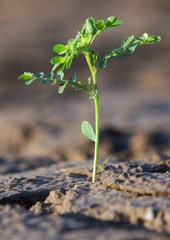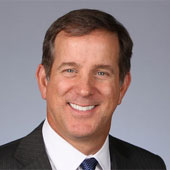Strengthening Resilience in Developing Countries
Can giant insurance companies help small customers in developing countries bounce back from environmental catastrophes?
March 30, 2013

What do a billion-dollar hydropower plant and a farmer in Ethiopia have in common? They can both be wiped out by drought. However, only one of them can have the insurance to recover from it.
The world’s large reinsurance companies — such as the company I work for, Swiss Re — are accustomed to mitigating risk on a very large scale, whether for bridges, tunnels, skyscrapers, massive floods or earthquakes. Our business is to spread the financial risk associated with these things all over the world.
By doing that, we ultimately help enable sustainable growth and resilience in communities around the globe. That is particularly important in this age of climate change and costly natural disasters.
And yet, there is something quite incongruent at the present stage: It is mostly clients in developed nations that seek the protection reinsurance provides. As a matter of fact, wealthy countries spend about 9% of their GDP on insurance cover, so they’re relatively well protected.
The comparison between developed and developing countries is stark, however. Developing countries spend less than 3% of GDP on insurance cover, and even that overstates the situation. In reality, many countries hardly have an insurance market to speak of.
This can have dramatic consequences for the livelihoods of the people involved. When Hurricane Katrina hit the U.S. Gulf Coast in August 2005, 2,000 people lost their lives. And the insurance industry paid out $70 billion — a record for a single event — a good portion of it coming from reinsurers like Swiss Re.
The year before Katrina, the Southeast Asian tsunami — one of the deadliest events in recorded history — killed over a hundred times more people in 14 countries. But insurers paid out 35 times less, approximately $2 billion.
This was a defining moment for us to really look for ways to end this inequity and to provide coverage for more people on this planet. The problem is that traditional insurance may not work in these vulnerable regions. But microinsurance can.
To see how, take the case Josette Lazzare. She is a working mother living near Les Cayes, Haiti. Josette has worked her way out of poverty. To provide for her family and keep a roof over her children’s heads, she took out a microloan to help her build and grow her small business, selling healthcare products.
That loan was provided by Fonkoze, the largest microfinance institution in Haiti. She started with a loan of about $30, ultimately ended up with a loan of over $1,000 — and then lost everything when a natural disaster hit.
She has been set back three separate times. Then, in the 2010 earthquake, she lost her husband. Without the ability to repay her loan, Josette is destined to fall back into poverty.
We see this play out time and again in countries where people are poor and susceptible to being hit with a natural catastrophe. It brought us to the question of how could we create insurance to help low-income populations on a scale and cost-benefit basis that was realistic.
Building resilience
Swiss Re has been in business for almost 150 years — always insuring very big things. The new task became how to leverage all of that experience and apply it on a micro level. Eventually, a partnership between Swiss Re, the Rockefeller Foundation and Oxfam America kicked off in a village in Tigray, Ethiopia. The goal of the project was to help the village build resilience against their greatest risk: drought, and the resulting crop failure.
To begin making a difference on a global scale and removing the existing inequity of who benefits from insurance coverage, we needed to create a model that could be replicated in other regions. By coupling very practical risk-reduction measures, like harvesting rainwater, with insurance for extreme drought, our project aims to help stabilize the village economy and encourage long-term sustainable development.
Working directly with farmers and the project partners, we adapted the concept of an insurance product that was originally designed for hydropower companies that wanted to hedge the risk of low precipitation rates. It works using a rainfall index. When rainfall is below a given level for a given period of time, it triggers a payment.
The Ethiopian project offers farmers this insurance in exchange for their work on risk-reduction measures in the village. In conjunction with insurance for extreme climate events, these measures — such as building better food storage facilities and using locally-produced fertilizers — help stabilize communities and encourage long-term sustainable development and adaption to climate changes.
This public-private partnership with the Ethiopian government is part of a public safety-net program that is addressing food insecurity. When the project started in 2009, there were zero insurance policies in the village. By the end of the first year, 200 people invested in them. A year later, it was 1,300. By the end of the third year, 13,000 had bought them across 45 villages in the area.
I realize that, in a country of 80 million people, 13,000 policies are a drop in the ocean. But look at it at the individual level — those 13,000 policies mean approximately 80,000 people benefit from insurance protection.
That is the power of microinsurance: Provide a villager with an insurance policy in these circumstances and you help enhance financial security as well as food security — and maybe even improve access to credit.
In the aggregate, it means building a more resilient, stable society, one in which families aren’t left destitute after a disaster. Over the next five years, the World Food Programme, the U.S. Agency for International Development, Oxfam America and Swiss Re have committed to a new project continuing the work in Ethiopia and bringing the model to three new countries. Approximately 520,000 people will end up benefiting.
The Ethiopian project has proved to be a very valuable exercise, but the journey is far from over. Building resilient societies and discovering how we as a company and an industry can serve the poor in a sustainable way takes a lot of time and perseverance. And it can feel daunting.
Along the way, what makes the difference is something that often sounds trivial, but is a key measure of performance in the business world of the future: how to improve people’s lives, especially in underserved markets in developing countries. Ultimately, that is an important way to make the world more sustainable and equitable.
Our company has always worked to enhance society’s resilience. But the way the business was structured for many decades meant that we did not focus on serving the most vulnerable people in the most vulnerable countries.
That has now changed. While there is still a long road ahead, working to build resilient societies and serving the microclient in locations around the world will increasingly become an integral part of our normal course of doing business.
Takeaways
Developing countries spend less than 3% of GDP on insurance. In reality, many countries hardly have an insurance market to speak of.
The Southeast Asian tsunami in 2004 killed over a hundred times more people than Hurricane Katrina, but insurers paid out 35 times less.
The problem is that traditional insurance may not work in vulnerable regions in developing countries. But microinsurance can.
Provide a villager with an insurance policy and you help enhance financial security as well as food security.
Read previous

Argentina: What the Pope Left Behind
March 29, 2013
